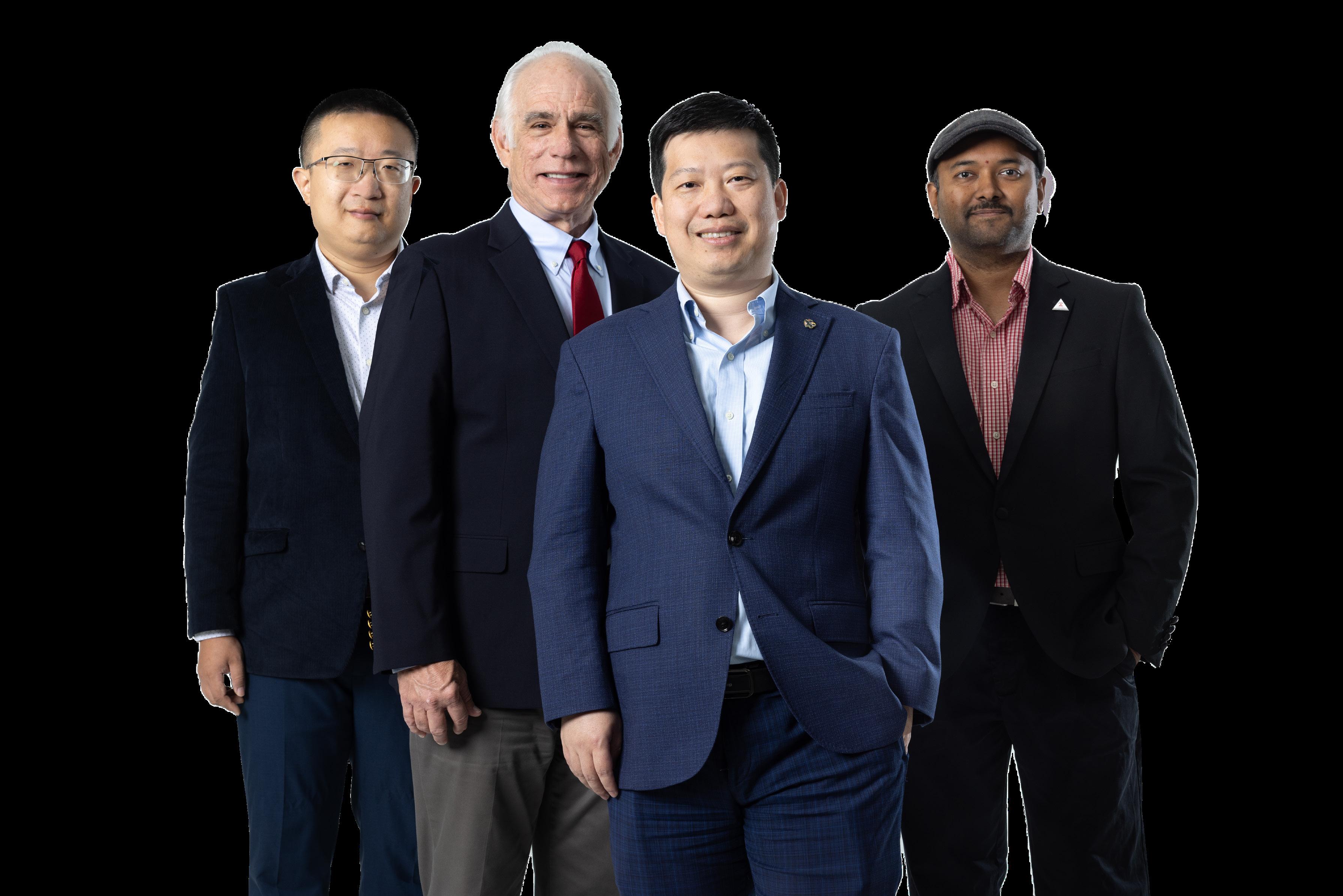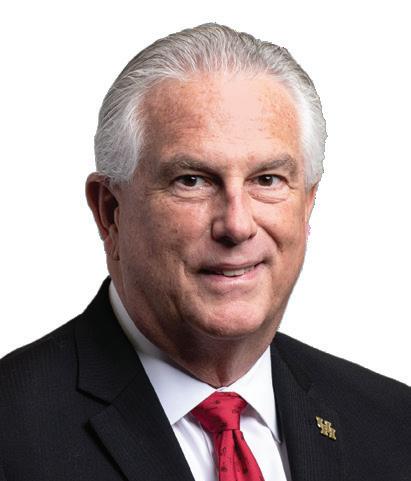ENERGY@SCALE
A PUBLICATION OF UH ENERGY

RESEARCH EXCELLENCE
Using robots to tackle the energy industry’s trickiest (and dirtiest) problems.

STUDENT SUCCESS
UH students team up to solve real-world energy challenges.


RESEARCH EXCELLENCE
Using robots to tackle the energy industry’s trickiest (and dirtiest) problems.

STUDENT SUCCESS
UH students team up to solve real-world energy challenges.
UH Energy experts say emerging battery, microgrid and AI technologies could be the answer to fortifying Texas’ ailing power grid — at least in the short term.




CHANGE IS A CONSTANT in the energy world. As The Energy University, we take pride in collaborating with industry and communities to create unique, real-world educational experiences that reflect today’s changing world.
The University of Houston’s research bridges fundamental principles and practical application, connecting innovation to at-scale, real-world challenges with a sharp focus on achieving affordability, reliability and lowering emissions (and not choosing energy sources).
In this issue, we highlight the NXplorers program, co-delivered with our strategic partner Shell, which showcases the power of collaboration and the development of critical thinking and creative problem-solving skills in multidisciplinary teams. We also spotlight Professor Aaron Becker’s cutting-edge research in robotics, demonstrating how innovation is making oil and gas exploration and production safer and more efficient.
As electrification continues to expand, UH’s exceptional faculty and students are exploring how the electric grid must evolve to serve as the unfailing backbone of society. Our feature story delves deeper into these critical issues, offering insights into the challenges and opportunities ahead. Alumna Roan Ferrier’s inspiring story underscores the importance of diverse perspectives and backgrounds in shaping our energy infrastructure.
Finally, we summarize the UH white paper “Workforce Development for the Future of Energy,” which outlines five key strategies to equip Houston’s workforce for the lowcarbon energy transition.
We value your feedback on the stories, research and insights shared in this magazine. Your engagement is key to shaping the future of energy, and we look forward to continuing the dialogue with you.
Thank you for your continued support of UH Energy.
Warm regards,
Ramanan Krishnamoorti Vice President for Energy and Innovation University of Houston



02

06 08 14 16

The Energy University®
VICE PRESIDENT
Ramanan Krishnamoorti
PUBLISHER
Lisa K. Holdeman
CONTRIBUTING EDITORS
Rashda Khan
Shawn Lindsey
Carrie Taylor
PHOTOGRAPHY & DESIGN
Marcus Allen
Jon Burke
Benjamin Corda
Jeff Lautenberger
Greg Ortiz
RESEARCH EXCELLENCE
The Robotics of Energy
Get to know the UH associate professor who uses robotics to solve tricky energy industry problems.
Building Future-Ready Workers
Five strategies from a UH white paper.
STUDENT SUCCESS Big Thinkers
Meet the UH team of winners from the Shell NXplorers event.
THOUGHT LEADERSHIP Reimagining the Grid
A power team of UH Energy experts could have answers to fortifying Texas’ ailing power grid — at least in the short term.
PERSPECTIVES
A Shifting Energy Landscape
Two UH Energy leaders weigh in on how political transition is expected to impact the energy landscape.
SPOTLIGHT
Roan Ferrier: Pivoting Her Way to Success
The UH alumna is building bridges through communication and creativity.

SVP, Growth & Strategy
Chris Phelps
SVP, Creative Services
Jennifer Chininis
EDITORIAL
Design Director
David Radabaugh
Managing Editors
Maria Hieber, Katie Stroh
Art Directors
Katy Rimer, Corrina Spurlin
Copy Editors
Staci Parks, Kelsey Kosh
BUSINESS
VP, Brand Strategy
Cory Davies
VP, Business Development
Ricardo Flores
Client Service
Elizabeth Allen, Brianna Barger, Rosalind Lynam

Meet Aaron Becker, an associate professor at UH’s Cullen College of Engineering, who uses robotics to solve some of the energy industry’s trickiest problems.
BY SHAWN SHINNEMAN | PHOTOGRAPHY BY JON BURKE / UNIVERSITY OF HOUSTON
AARON BECKER HAS always been interested in robots. It’s just that, up until he decided to pursue postgraduate studies, he could never quite get his hands on one.
He asked Santa Claus for a robot when he was 6, but it never came. As an undergrad at Iowa State University, he figured a degree in computer science might be the ticket. No such luck.
“I said, ‘Man, I’ve got to go back to grad school. I want to make sure this time,’” Becker says. “I want to understand [robotics] and figure out how to make things move and change their environment.”
A program in control systems at the University of Illinois Urbana-Champaign finally introduced him to the world of
robotics. Since earning a Ph.D. in electrical and computer engineering in 2012, Becker hasn’t looked back.
He joined the faculty at the University of Houston in 2014, where he runs a swarm robotics lab and works as an associate professor at the Cullen College of Engineering. He also manages a YouTube channel (youtube.com/@AaronBecker), where his videos have garnered tens of thousands of views.
Solving problems within the energy industry has become a major area of focus. Becker has spent the last decade researching and developing processes that keep workers safer, improve productivity and optimize systems within the industry. The trick, he says, is to get your hands dirty, identify a pain point and use robotics to solve the issue.

Becker’s robotics research prioritizes improving worker safety and optimizing energy systems.
OR SWIM

Becker doesn’t see robotics as a replacement for human jobs. Although some kinds of jobs may go away entirely, most robots will simply allow human workers to become more productive.
“We’re pushed by novelty,” Becker says. “As a professor, writing the third paper about a topic is no good. But finding some ideas that haven’t been applied and where you can show a benefit — that’s a happy spot to be.”
It just so happens that the industry is ripe for the sort of problem-solving Becker gravitates toward. The “three D’s of robotics” dictate that robots can help humans do jobs that are dirty, dangerous or dull. The energy sector has all three in spades.
First, the dirty, which can mean many different things. Something can be dirty because it’s full of carcinogens, for instance. Other times, we’re talking about work carried out inside dark and grimy locations, as in mining or extraction.
“The typical view of an oil well is a very dirty place,” Becker says. “If you can make a robot or machinery do that, it’s much better for the human.”
Those places come with their own dangers, as well. But Becker’s go-to example of a dangerous job best fit for a robot happens
thousands of feet under water, where atmospheric pressure introduces massive risk to human workers.
Finally, the dull. Whereas the human brain can get bored and tired, reaching a point of diminishing returns, “A robot can inspect 10,000 bolts with exactly as much enthusiasm as it had for the first 10,” he says.
All that said, Becker doesn’t see robotics as a replacement for human jobs. Although some kinds of jobs may go away entirely, most robots will simply allow human workers to become more productive, focusing on the highest-value tasks.
When it comes to the energy industry, robots aren’t some far-out idea. They’re here, and they’re creating a massive amount of efficiency.
“We’ve already turned the corner,” Becker says. “A refinery is basically an enormous robot. You’ve got pumps, you’ve got heaters, you’ve got sensors everywhere, and they’re all flowing into computers that are making all sorts of decisions beyond what any one person could do.”
Use cases abound. In one growing trend, oil and gas companies are attaching a robot to a portion of a 3-mile-long drill string, allowing constant assessment and analysis.
Drones, too, have become a massive piece of the puzzle, helping detect what human senses cannot. “They can see a chemical leak,” Becker says. “They can tell if there’s carbon dioxide or methane that is bubbling off from something. Those are superhuman abilities.”
They can also reconstruct an entire facility in digital form, mirroring the physical components down to the millimeter. “You can zoom in and see how rusty every bolt is,” Becker says.
Of course, these new technologies also present new challenges. Drones and many other kinds of robots must be able to move around freely, for instance, but doing so for an extended period requires significant battery power. It’s vitally important, then, that we scale up both our battery availability and our ability to store renewable energy such as solar.
“These are true constraints,” Becker says. “They’re problems that are going to keep Ph.D. students and the industry working for a long time.”
Five strategies for developing Houston’s energy workforce.
AS THE GLOBAL ENERGY LANDSCAPE shifts toward sustainable solutions, the Greater Houston area — already an established hub for global traditional energy — is a key player in the low-carbon transition. In addition to technological, policy and financial implications, the transition’s impact on Houston’s diverse workforce is a pressing concern.
“Workforce Development for the Future of Energy,” a new white paper published by the University of Houston’s Division of Energy and Innovation, lays out five key strategies to equip the region’s workforce for this new era and make the most of future opportunities.
Scan the QR code to read the entire white paper, “Workforce Development for the Future of Energy.”
With so much of Houston’s employment tied to energy, the low-carbon transition will have far-reaching effects.
Collaboration between industry, schools and training organizations is crucial. By aligning skill-building programs with real-world demands, Houston can develop a workforce ready to lead in emerging sectors such as hydrogen and renewables.
Practical experience is essential for success in energy’s emerging roles. Expanding internships, apprenticeships and preapprenticeships will allow workers to gain skills directly applicable to their careers through paid, hands-on training.
Workforce development must be accessible to all. Offering multiple training approaches, from industry-led programs to communitybased courses, will ensure both new and current workers have the resources to adapt and thrive.
An inclusive workforce transition demands we support all community members. Removing barriers is key to an inclusive workforce. Expanding support services such as childcare, transportation and financial aid will enable more people to participate in training and job opportunities.
Initiatives like career fairs and science, technology, engineering and math outreach should begin well before high school graduation, making students aware of career paths in energy and preparing them early for the steps they need to succeed.
The future of the energy sector in Houston and beyond depends on a skilled, adaptable and inclusive workforce.
Based on a collaborative white paper written by UH Energy and Innovation Hydrogen Program Officer Paul Doucette, along with contributions from Ramanan Krishnamoorti, Alan Rossiter and Aparajita Dutta, University of Houston; Anne Bartlett, Brazosport College; Rocky Barney, College of the Mainland; Jay Culver, San Jacinto College; Steven Kahla and Christa Spears, Lone Star College; Michael Webster, Houston Community College; and Melvin White, MRSW Management LLC.
Average annual salary of new jobs in the emerging hydrogen ecosystem
Energy companies based in Houston
New jobs in the Greater Houston area created by the emerging hydrogen ecosystem alone
Houston’s employment tied to energy
A multidisciplinary group of UH students teamed up to tackle global sustainability challenges at Shell’s NXplorers event.
BY RASHDA KHAN
PHOTOGRAPHY BY
JON BURKE / UNIVERSITY OF HOUSTON
IN A WORLD full of complex challenges and hungry for sustainable solutions, 35 University of Houston students stepped up to innovate, collaborate and reimagine the world by participating in a Shell NXplorers event at UH in the fall of 2024. At the end of a rigorous yet career-defining week, Platinum Frontier Energy, a team of six undergraduate and graduate students from economics, chemical engineering, physics, management information systems, finance and political science won first place.
Their proposal focused on using green hydrogen fuel — a clean energy source that emits only water vapor — to reduce air pollution in industrial neighborhoods. The solution was praised for its feasibility and potential impact on community health.
“Participating in Shell NXplorers reaffirmed my belief that collaboration and innovation are key to solving global challenges,” says senior economics major and team member Kamaldeen Haruna. “I gained a deeper understanding of systems thinking and the value of collaboration in solving complex problems.”
Other team members included Kenneth Kusima, a chemical engineering doctoral student; Benise Niyikiza, a physics doctoral student; Nidhi Gongati, a management information systems graduate student; Joshua Holl, a finance graduate student; and Gerardo Angulo, a political science junior.


Shell and UH’s Division of Energy and Innovation partnered to bring Shell NXplorers to UH. The program is designed to equip future leaders with new ways of thinking and to grow an engaged, ambitious global community with the confidence, skills and vision to address local and global challenges, as underlined in the United Nations’ Sustainable Development Goals.
“This partnership between Shell and the University of Houston exemplifies how academia and industry can collaborate to tackle the energy challenges of our time,” says Ramanan Krishnamoorti, vice president of energy and innovation at UH.
Shell and UH — The Energy University — have a long-standing partnership focused on

addressing complex energy challenges through strategic collaboration, leveraging resources, and developing talents and skills of future energy leaders. This relationship, originally fostered through Shell’s Campus Ambassadors program, includes a transformative $10 million contribution from Shell USA Inc. and Shell Global Solutions (US) Inc. that established the UH Energy Transition Institute in 2022.
Recognizing the need for broader skills such as collaboration and systems thinking, Shell and UH leaders hosted the NXplorers event to prepare students for tackling complex global issues.
Build them up, set them loose
From more than 100 applicants, 35 top students were selected for a two-day workshop


led by a team of experienced energy leaders from Shell. Participants were introduced to tools such as systems thinking, scenario planning and change management, and they worked in interdisciplinary teams to explore solutions to energy challenges.
Following the workshop, a week of mentoring sessions helped the groups refine their ideas and pitch them to a panel of expert judges from Shell and UH.
May Shek, market development manager at Shell Chemical and Shell UH campus recruiting manager, served as a judge. From her front-row seat, Shek observed students transforming from strangers to collaborators.
“I was inspired by the growth of the students in such a short time,” she says. “The program encapsulates what we look for in future employees and future leaders in the industry:
the ability to tackle complex problems while collaborating with a wide range of stakeholders.”
The event united participants from diverse academic disciplines, bringing a variety of perspectives to the table. The students learned to break down multifaceted problems, identify interconnected elements and approach challenges with a holistic mindset.
Holl, who eventually wants to work in renewable energy, appreciated the teamwork the task required.
“My favorite part was how my group, having never met before, came together to accomplish an amazing feat within one week,” he says. The diverse backgrounds of the teams were
a strength, according to Kusima, who wants to develop broad skills that will let him take advantage of future opportunities in both academia and industry.
“Each member brought unique skills, knowledge and perspectives, yet we shared a passion for learning and openness to new ideas,” he says. “This dynamic allowed me to learn something valuable from everyone.”
Holl found the workshop’s emphasis on critical thinking rewarding. “It was an opportunity to develop a skill that you often can’t find training in: critical thinking and truly understanding a problem instead of just speeding toward a solution.”
Gongati, who is interested in leveraging technology to drive sustainable initiatives that impact public health, was impressed by Shell’s methodology.
“The exploration of risk identification and mitigation strategies opened my eyes to potential risks I had never considered before,” she says. “We delved from higher-level risks to lower-level risks, thoroughly breaking down each one. This analytical approach was invaluable.”
The NXplorers event was more than just a workshop; it was a transformative experience that equipped students with the skills necessary to lead the energy transition and shape a path toward a more sustainable future.
“My hope is that students continue to harness their ability to think bigger, to see the bigger picture, and to understand the power of shifting their perspective and working with other people,” says Shell NXplorers global lead Tariq Hussain.
Krishnamoorti emphasized the program’s role as a bridge.
“This program is a testament to what’s possible when academia and industry collaborate,” he says. “These students are equipped to drive meaningful change, shaping a healthier, low-carbon future for us all.”



UH Energy experts say emerging battery, microgrid and AI technologies could be the answer to fortifying Texas’ ailing power grid — at least in the short term.
BY SAM EIFLING | PHOTOGRAPHY BY JON BURKE / UNIVERSITY OF HOUSTON







WARNING SIGNS
UH Energy Fellow Ed Hirs has been sounding the alarm on Texas’ grid reliability crisis for years.

The past few years have made one thing clear: The Texas power grid needs to get stronger and smarter if it’s going to keep up with the state’s needs.
The Texas grid presently is capable of producing and delivering about 9 gigawatts of electricity. Most days, people use that power in their homes and businesses without a second thought.
Yet the simplicity of flipping a switch or throwing a breaker masks an immensely complex system in which inputs must match outputs, prices matter nearly as much as physics, and the harmony of power generation and power transmission is in constant flux. Existing technology solutions already are helping to fortify the grid. Batteries, microgrids and innovative artificial intelligence
software all assist in making Texans’ electricity generation and delivery cheaper, more efficient and more resilient.
But those innovations, while promising, may ultimately amount to half measures that can’t offset the deeper economic and political issues that make the grid a source of profound worry for Texans.
Ed Hirs, the inaugural University of Houston Energy Fellow and a lecturer in the Department of Economics in the College of Liberal Arts and Social Sciences, has argued for years that Texas’ biggest hurdle to a reliable grid is its economic model. The state government has created a marketplace that fails to encourage new producers to enter or to reward existing producers for maintenance and upkeep.
During eight of the 10 years prior to 2021, Hirs says, the average price paid for electricity in the Texas market was less than what a utility would need to make
Hugh Roy and Lillie Cranz Cullen Distinguished Professor Yan Yao says Texas is primed for the adoption of battery power storage solutions.
to invest in a new plant. Without offering an expected rate of return, Texas is not seeing power plants come online fast enough to meet future needs.
“It’s a market design issue much more than it’s a technical issue,” Hirs says. “If you don’t allow anybody to make a rate of return, they’re not going to be there. ... Wall Street won’t let you build power plants just to lose money.”
Hirs is passionate about the issue, in part because two immutable factors are putting increasing pressure on the grid.
The first is simply rapid growth in demand. Texas has added almost 1 million more residents (and their economic activities) since 2021, and the state continues to grow. To keep up, the Electric Reliability Council of Texas, or ERCOT, may need to double its supply capacity as soon as 2030.
The second factor is the increasing frequency and danger of weather disasters. Statewide
heat domes and polar vortexes strain the infrastructure across Texas. The average coal power plant is now 55 years old, while natural gas power plants have been around more than 30 years on average. Their rate of breakdowns is also the highest in the nation.
If a statewide winter storm were to knock out both wind and solar farms, there would not be enough coal, natural gas and nuclear power plants to meet winter demand. The National Centers for Environmental Information at the National Oceanic and Atmospheric Administration counted about 1.4 such disasters per year during the 1980s. That number has increased about tenfold during the 2020s.
A plan for a more resilient grid must account for such extreme events. When those hurricanes and winter storms and wildfires strike — simultaneously knocking out power transmission and raising the demand for energy — the grid risks breaking.
During the winter storm of February 2021, the grid was less than five minutes from a complete and catastrophic collapse before ERCOT shut down parts of it. Hundreds of Texans died of
than 1 million did — and without getting anything in exchange.”
In the meantime, the prospect of a full collapse has worried Hirs for years. Imagine, he says, “26 million people without fuel, without clean water, without sewage, without anything that electricity provides. How many Berlin Airlifts would it take to keep Texas alive? We’ve got natural gas, but you need electricity to make sure there’s integrity to the natural gas network itself. It’s the Achilles’ heel of this nation’s national security.”
To stave off that scenario, and to buy time for Texas to make structural changes, these new technologies may become indispensable.
They’re not yet big enough, cheap enough or reliable enough to fully make up for the shortcomings of the Texas grid. But batteries are a significant and fast-growing component of the state’s power supply. In May, Texas saw a single-day record of 3.2 gigawatts of batteries simultaneously discharging to the grid, accounting for about 5% of the state’s electricity load.

That capacity is only projected to increase as the state brings ever more solar and wind capacity online. Fluctuations in sunlight and wind make batteries an essential complement to renewables in particular.
“Texas is uniquely equipped for rapid growth for utility-scale battery storage,” says Yan Yao, Hugh Roy and Lillie Cranz Cullen Distinguished Professor in the Department of Electrical and Computer Engineering at the Cullen College of Engineering and principal investigator of the Texas Center for Superconductivity at UH. Yao and his research team are globally known for their work to create next-generation batteries.
An AI tool that balances inputs from batteries and other clean backup resources , weighing the moment-to-moment price fluctuations from different primary energy sources, could help the grid run smoothly at full capacity .
“This shift in energy storage would coincide with volatile weather conditions and rising demands on the energy infrastructure. So that is definitely a positive and fast-moving field.”
Protecting people from volatile weather is a key driver of battery adoption. A Harris County initiative is equipping community buildings, such as senior centers and libraries, with solar panels and batteries to ensure these gathering spaces can be used reliably during emergencies, including heat waves, when people need cooling centers.
But batteries still face a few daunting obstacles on the way to wider adoption.
Most of the current battery technology used in home or building construction is similar to what electric vehicles use: lithium-ion batteries capable of only a couple of hours’ worth of storage. While their prices have come down steeply in the past decade, Yao says those batteries need to get significantly cheaper for people to adopt them more broadly.
Lithium-ion batteries also pose a notable fire risk — no small consideration when weighing the best options for a home. And, vexingly, they offer the best performance at moderate, pleasant temperatures and falter somewhat in very cold and very hot conditions — exactly the weather that makes outages more likely. The very slow process of mining lithium adds another drag to batteries’ production and advancement until other emerging technologies, such as sodium ion batteries, can be improved and manufactured.
So, the drawbacks are significant. But Texas will be counting on greater battery capacity to keep pace with the demands on the grid, especially as drivers transition to electric vehicles and more renewable production comes online.
“We need a hundred times more storage, looking at the next 10 years,” Yao says. “The cost of the battery really has to go down further to enable the bigger, full-scale transition.”
Think of your traditional grid as a one-way system in which a producer generates energy at a remote location and then a complex network delivers energy to your home or business. That system is vulnerable to extreme events — storms, heat waves — because it must constantly balance supply and demand. When a producer or some portion of the delivery network breaks, you can lose power.
To prevent a loss of power, many people around the world are turning to smaller, more contained power-generating and transmission networks, known as microgrids. When connected to the grid, microgrids can operate in harmony with that wider network.
And when disconnected from the grid, microgrids can stay up on their own, powering a specific user — a university, say, or maybe a warehouse or even a neighborhood — for two or three days. Communities in California, Chicago and Detroit have invested in microgrids in recent years.
SUPPLYING DEMAND
Jian Shi, UH associate professor of electrical power engineering technology, envisions building a “virtual power plant” to integrate a variety of energy sources under one platform.



through the grid or a microgrid. The complexity and speed necessary for such a task makes it perfect for a machine to handle.
An AI tool that balances inputs from batteries and other clean backup resources (such as renewable natural gas generators or hydrogen fuel cells), weighing the momentto-moment price fluctuations from different primary energy sources, could help the grid run smoothly at full capacity. And it could do so while ensuring that people who connect their
“At the same time, how can they ensure that there will be sufficient resources available to satisfy the daily local energy needs and during potential power outages?”
The answers to that equation may not make up for large-scale, storm-damaged hardware or a lack of power plants in the state from the grid’s perspective. But on very hot days, or very cold days, optimizing every potential input may mean a big difference in price and reliability to Texas power customers.

BY RASHDA KHAN
THE 2024 ELECTION proved momentous for Republicans. With a newly reelected President Trump and a Republican majority in Congress, the future path of energy transition investment faces uncertainty and potential transformation.
Under the Biden administration, the Inflation Reduction Act dedicated $369 billion to clean energy, spurring investments in renewables, electric vehicles and energy efficiency while setting ambitious goals like carbon neutrality by 2050. According to data released by the White House and reported by media outlets, the Biden-Harris administration’s agenda has catalyzed $1 trillion in manufacturing, infrastructure and clean energy investments since 2021.
Now the question is, what happens to these investments and projects with the change in administration? Two University of Houston energy leaders weigh in from their policy and research perspectives.
Charles McConnell is the executive director of UH’s Center for Carbon Management in Energy. His 40-year energy industry background includes serving as an assistant secretary of energy with the U.S. Department of Energy, vice president of carbon management at Battelle Energy Technology, and vice president of energy and hydrogen and other roles with Praxair Inc. McConnell is a board member of the Energy & Environmental Research Center Foundation and MAC Copper Ltd.
Joseph B. Powell, a member of the National Academy of Engineering, is the founding executive director of the UH Energy Transition Institute. He served as Shell’s first Chief Scientist – Chemical Engineering from 2006 to 2020, culminating in a 36-year industry career where he led research and development in new chemical processes, biofuels and enhanced oil recovery, and advised on global strategy.
THE FUTURE OF energy-related policies largely depends on politics and the geographic areas where such policies would have the most impact. The Trump administration’s intent to exit the Paris Climate Accord is already shaping expectations, but impacts will vary, and that is where the nuances lie.

In the electric power market, federal support for wind and solar is expected to decline, with reduced subsidies, investment tax credit cuts, and tariffs on Chinese solar products increasing costs and slowing deployment. Conversely, nuclear energy will gain support for technological advancement, market integration and pathways to more broad commercialization.
Coal does not compete with natural gas-fired power units in the United States and is unlikely to make a comeback in our country. Globally, however, coal will continue to grow — and U.S. coal exports along with it. Natural gas is set to take an expanded role in electricity generation due to the need for significant growth in dispatchable 24/7 generation, and carbon capture utilization and storage will strategically accompany such generation for economic benefits through enhanced oil recovery as a CO2 emissions solution. Liquified natural gas is expected to flourish to enhance global energy security, increase our export balance of trade and position LNG as a geopolitical and economic tool.
Inflation Reduction Act-related spending will have varying levels of support or not. An example is the hydrogen hubs that are facing significant headwinds due to a lack of market demand and cost to produce. Energy security, reliability and cost will be the primary drivers.
Projects and the related community engagement will be driven by accelerated permitting and the development of skilled and capable workforces to not only construct but produce with American made products and skills.
Finally, discussions about cross-border carbon tariffs and pressure on China and the EU for carbon dioxide reductions prior to 2030 may be interlinked with trade agreements. What is clear is that the United States will not be funding global climate efforts for other countries and creating economic headwinds for our industries.
RESEARCH PROGRAMS SHOULD address expanding economic access to energy and critical materials. Natural hydrogen and geothermal energy research can potentially leverage learnings from unconventional oil and gas production. Wind and solar remain low-cost options for instantaneous power; and, their market potential can be further leveraged by research into advanced materials for energy storage, making use of new computational methods for low-cost materials discovery, including artificial intelligence and machine learning.

Computational methods can also reduce the costs of technology demonstrations and scale up. Expansion of these capabilities will help the United States remain a leader in the marketing of energy technology, whether deployed domestically or abroad. New pathways to extract and recycle materials for energy and chemicals can reduce environmental burdens and potentially provide lower-cost feedstocks while also offering access to critical materials necessary for U.S. economic growth.
Technology development to reduce costs to U. S. and/or global consumers will continue to be an attractive investment, regardless of variations and durability of global policy incentives. In the end, those technologies that provide the lowest cost and best environmental performance will be advantaged.
The University of Houston — known as The Energy University — aligns research with industry needs through initiatives like the Energy Transition Institute and the Center for Carbon Management in Energy. These programs tackle key areas such as energy storage and transport, materials recycle, and carbon capture and storage.
UH’s collaborations, including its carbon storage and hydrogen transportation grants as well as partnerships with Argonne National Laboratory, emphasize targeted research to solve pressing issues. Digital modeling, led by UH’s Hewlett Packard Enterprise Data Science Institute, reduces costs of discovery and deployment, integrating technoeconomic and life-cycle systems analysis. UH attracts industry funding and drives the innovation necessary to expand energy access.
BY RASHDA KHAN | PHOTOGRAPHY BY JEFF LAUTENBERGER / UNIVERSITY OF HOUSTON
Houston graduate Roan Ferrier (B.A. ’19) is a testament to her adaptability and the power of saying yes to unexpected opportunities.
With a bachelor’s degree in media produc tion and a minor in dance, she expected to be a music video editor. But a chance encounter changed her path. Ferrier now works as a communications specialist for Chevron New Energies.
“I never thought I was going to end up in the energy industry because, grow ing up, I didn’t like math, I didn’t want to be an engineer,” she says.
On how she pivoted from ballet to energy: Ferrier danced from ages 3 to 24, performing with prestigious Houston companies. She says ballet taught her determination, confi dence and a focus that continues to guide her professionally. It was a chance encounter with someone she knew through dance that opened the door to a role in energy. That opportunity was the beginning of what she describes as a “huge leap of faith” — one that has led to her current role at Chevron.
On her new routine: manages Chevron New Energies’ LinkedIn presence and crafts internal messaging to improve understanding of the company’s mission to advance a lower-carbon energy future. Without a technical background, Ferrier has leaned into the challenge of learning the industry’s intricacies.

I’ve come to realize how vast and diverse the energy industry is. It’s not just STEM; it takes people from all walks of life to drive innovation and solutions.
“It’s daunting,” she says. “But work helps propel the world forward, even in a small way,
For those following in her Ferrier’s advice is to network relentlessly talents. “I’m naturally quite shy, but I learned that you have to put yourself out there,” she says. She credits UH’s Jack J. Valenti School of Communication for setting her up for success by providing opportunities to meet prospective employers through job fairs and internships.
“Everything built on itself,” she says. “If I hadn’t gone to that first job fair, I don’t think the rest of it would have happened.”
Explore the science, policy and business perspectives on plastics circularity. This symposium, presented in collaboration with the UH Energy Transition Institute, is intended to bring together industry leaders, researchers, policymakers and students to share insights and drive action for a circular plastics economy.
APRIL 17, 2025
8 AM – 6:30 PM




